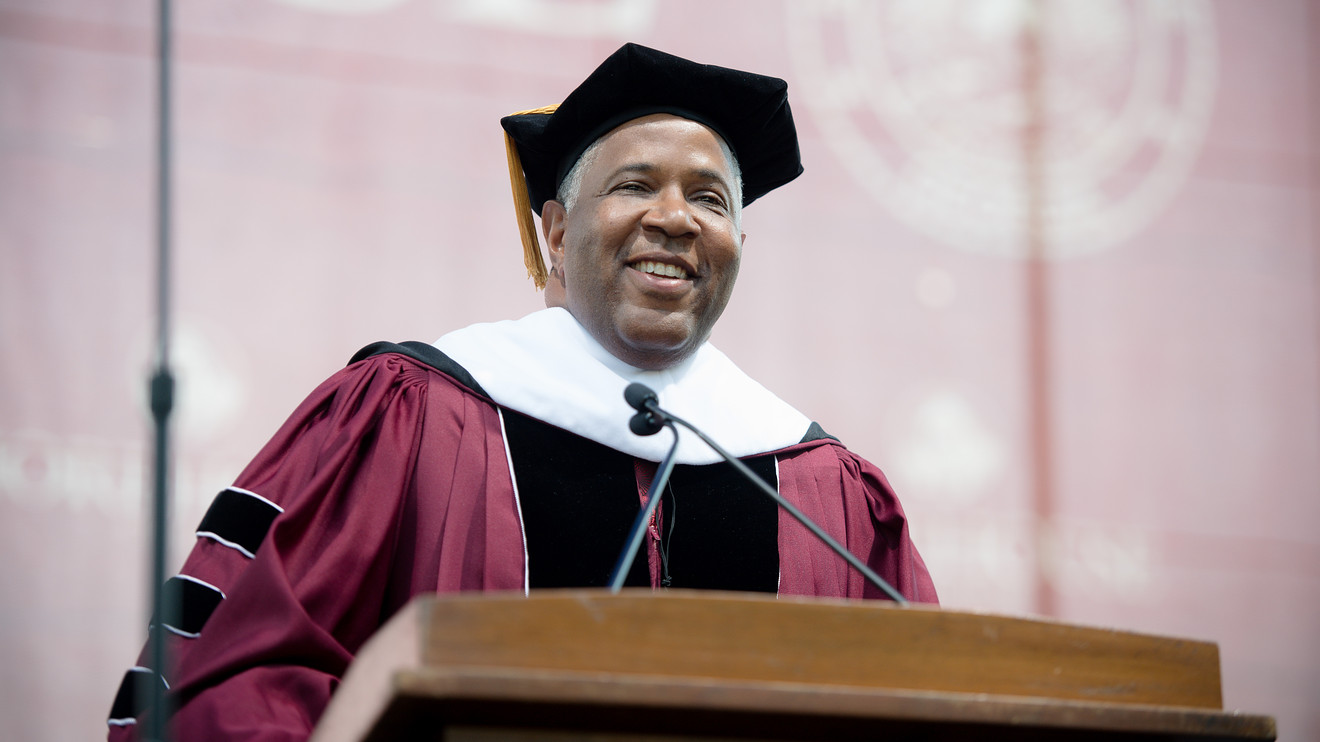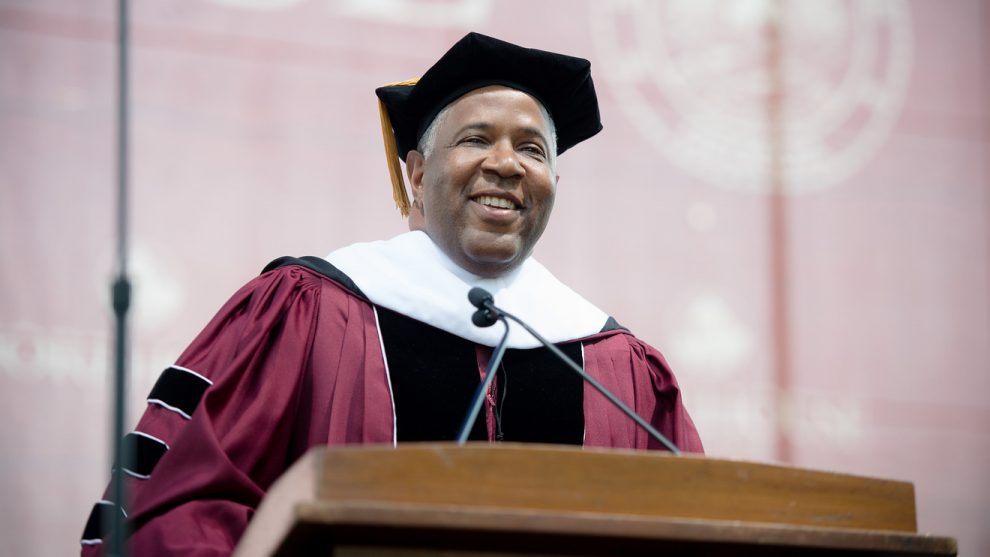
The billionaire who’s paying off the student loans for this year’s Morehouse College graduating class has raised the donation bar so high that he’s making Oprah Winfrey look almost stingy.
Vista Equity Partners founder and CEO Robert F. Smith pledged an estimated $40 million to the 396 grads in the class of 2019. They’ll look to enter the workforce this year with a debt-free slate, in what is reportedly the largest one-time gift in school history.
“We’re going to put a little fuel in your bus,” Smith told the graduates at commencement over the weekend.
Related: Happy graduation! Billionaire pays off Morehouse College grads’ student-loan debt
And as a result, giving queen Winfrey has been called out on Instagram for not doing the same when she gave the commencement address at Colorado College over the weekend. One follower wrote on her Instagram page that Winfrey “should have paid off their student debt.”
The media mogul’s account responded that she has paid $13 million in scholarships and helped put more than 400 men through school at the all-male Morehouse since establishing the Oprah Winfrey Endowed Scholarship Fund at the school in 1989. What’s more, she gave $500,000 to a Newark, N.J., high school on Tuesday to support its after-school program.
But Smith’s gesture is not only almost four times greater than Winfrey’s — and given to a single graduating class as opposed to being parsed out over four decades — his student loan payments have also captured the public’s attention because he’s giving the gift directly to the grads to launch their careers. That flips the script on how billionaires usually benefit students and schools.
“Historically, donors gave more students access to education through scholarships. Mr. Smith was saying, ‘I’m giving you access to your lives,’” Jason McNeal of fundraising consulting firm Gonser Gerber told MarketWatch.
Smith is also benefiting an HBCU (Historically Black Colleges and Universities), and students at these schools have historically been hit the hardest by the $1.5 trillion student-debt crisis, shouldering a median federal-debt load of about $29,000 at graduation, the Wall Street Journal reported. That is 32% higher than the debt carried by graduates of other public and nonprofit four-year schools.
Morehouse’s tuition for the 2018-19 school year was about $28,000, and two-thirds of its students received federal student aid, the Atlanta Journal-Constitution reported, with some graduates owing as much as $100,000 in student loans.
“We often see these big gifts from donors to college campuses directed at schools that either don’t enroll a high share of students of color or low-income students, often in service of putting their name on a building or funding a very narrowly focused scholarship program. This is very different from that,” Mark Huelsman, associate director of research and policy at Demos, a left-leaning think tank, told MarketWatch.
“This is something that is aimed at transforming the lives of a group of graduates from an institution that has a lot of history in creating and maintaining the black middle class,” he continued. “If you compare this to some of the other gifts given in higher education, it’s incredibly stark, and I would hope points us to a smarter, better model of philanthropy where people’s lives are genuinely being transformed.”
Indeed, about 28% of the total $46.73 billion donated to universities last year went to 20 elite colleges and universities like Harvard, Stanford and Columbia that serve just 1.6% of the nation’s 19.9 million undergraduate students.
“When we’re talking about a massive donation to a college, it’s typically an elite college that already has a lot of money and primarily serves wealthy students. You do not see that kind of donation to HBCUs and HSIs (Hispanic-Serving Institutions),” agreed Antoinette Flores, the associate director for post-secondary education at the Center for American Progress, a left-leaning think tank. “Investing in your community college, HSIs, HBCUs and public universities is where your dollars are going to have the greatest impact.”
Another reason traditional donations to new buildings or scholarship funds may not always get as much attention as Smith’s unprecedented gift is that it can be difficult to measure their impact. “When you put money in a building, what does that mean to students, especially since they mostly only serve wealthy students anyway?” asked Flores. In comparison, paying off students’ debt “is a way to target your dollars to impact equity in America,” she said. “Smith is impacting the wealth gap and bringing attention to the colleges that do the brunt of the work providing educational access and opportunities to communities that need it.”
But McNeal of Gonser Gerber noted that all gifts to higher education institutions compliment each other, so those old-school donations still matter. Indeed, Smith also donated $1.5 million to Morehouse earlier this year to fund endowed scholarships and to create a park where students can study.
“Those scholarship dollars help many students get into institutions that would otherwise not be able to,” McNeal said. Many non-elite institutions also wouldn’t have the money to fund constructing or renovating buildings on campus, or creating new programs, without the help of philanthropy. And as undergraduate and graduate enrollment has declined 9% since 2011, according to the National Student Clearinghouse, many private colleges and universities have been hit hard by those lost tuition revenues.
“If you don’t have donors doing that more traditional giving on the front end, then what Mr. Smith did in this one instance on the back end [paying off debt] wouldn’t really matter much, because we wouldn’t have the strength of institutions that we have today without this donor’s margins, and those more traditional types of giving,” McNeal said.
Still, Smith’s gift is sparking a conversation about the best way to give back as philanthropy spending has passed $400 billion a year. “We are living at an exciting cultural turning point when it comes to wealth, plutocracy, philanthropy and democracy,” Anand Giridharadas, the author of “Winners Take All: The Elite Charade of Changing the World,” told MarketWatch. “Each donation is ‘great’ with an asterisk. We have to ask questions,” about the larger problem a donation aims to fix, as well as where the donor money is coming from.
For example, he cited the skepticism over Amazon AMZN, +0.12% CEO Jeff Bezos launching a $2 billion program to support homeless families and education programs last September. “There was gratitude, but also questions of, are you paying people [at Amazon] enough? Are you contributing to the very same homeless problem you seek to solve?” he said.
Giridharadas also pointed out that Smith supports the carried-interest tax loophole that gives a tax break to many wealthy private-equity managers, so they’re probably not paying the same tax share as many Morehouse grads will soon be.
So even Smith can do more. “I think gifts like [Smith’s] are great… but what if in place of that, he spent $40 million on the issue of fixing student debt, or closed the carried-interest loophole,” he said. “There are probably other ways of spending the $40 million; political training and advocacy might be better able to start moving the needle on solving the problem.”
Flores agreed that we can’t rely on billionaires to bail graduates out. “For every student that gets their loan forgiven, you have dozens more waiting and suffering,” she said. “We need government investment in higher education and a solution to the student debt crisis.”
With additional reporting by Jillian Berman



